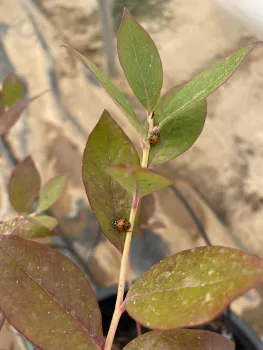General Information
Blueberry plants (Vaccinium corymbosum) are perennial, bush-like plants in the family Ericaceae. They prefer acidic, well-draining soils and require nitrogen in the form of ammonium (Strik et al. 2020). There are many different blueberry varieties that produce fruit of varying size and flavor during different times in the season. Different blueberry varieties also require different chill hours, the number of hours under 45°F required for fruit set to occur. Varieties with low chilling requirements are best for the San Diego area because of the climate in the county.
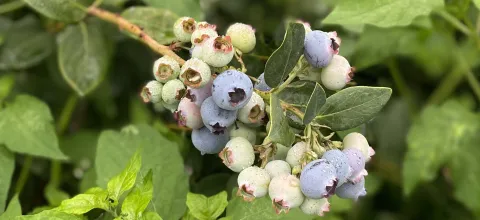
We chose several low-chill varieties to grow in this experiment. The 3 main varieties we are growing are Snowchaser, a very early season variety, Misty, an early season variety, and Star, a mid-season variety, but we are also growing Farthing, Meadowlark, San Joaquin, Jubilee, and Sunshine Blue. We will be collecting fruit yield data and comparing these different varieties and several different treatments. For additional information about each variety see the table below. Click here to see photos of each variety. To see which variety is producing the most fruit, check out our Harvest Tracker.
Blueberry plants used in this project were obtained from Fall Creek Nursery in Lowell, Oregon.
Blueberry Variety Characteristics
Variety | Plant Size | Chilling Level | Ripening Season | Berry Size | Berry Qualities | Primary Use | Other |
Snowchaser | Rounded, vigoroso | Low chill | Very early | Medium | Medium blue, firm, good flavor | Fresh, processed | Earliest ripening Southern Highbush (April/May) |
Misty | Upright, vigoroso | Low chill | Early | Medium to large | Firm, mild, sweet flavor | Fresh market | Must be pruned heavily, planted as a pollinator |
Star | Upright, vigoroso | Low chill | Mid | Medium | Medium blue, sweet, outstanding quality | Fresh, processed | Susceptible to Botrytis grey mold and fruit cracking |
Farthing | Compact, rounded | Low chill | Early | Medium to large | Crisp, firm, mild tart flavor | Fresh market | Disease resistance, mechanical harvest candidate |
Meadowlark | Upright, vigoroso | Low chill | Very early | Large to very large | Excellent firmness, scar may be large | Fresh | Susceptible to Xylella, ‘Funky Spot’ Virus, and blueberry red ringspot virus |
San Joaquin | Upright, vigoroso | Low chill | Mid/late | Very large | Light blue, high yield | Fresh, processed | Mechanical harvest candidate |
Jubilee |
| Low chill | Mid | Medium | Fresh, sweet |
|
|
Sunshine Blue | Semi-dwarf, evergreen | Low chill | Early | Medium | Richly sweet |
| Hot pink flowers |
Plant Health Management
We are testing two growing substrates: a pre-made acid-loving plant mix and a custom mix of bark, peat moss, and perlite. We are also testing three fertilizers: ammonium sulfate and two other fertilizers made for acid-loving plants.
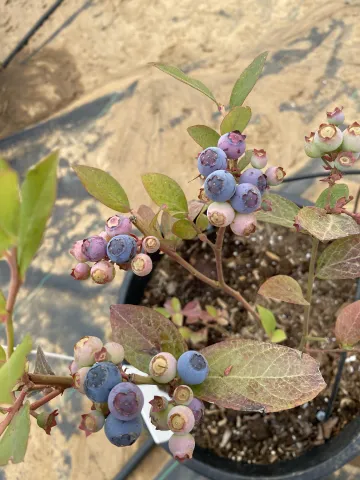
Pests and Diseases
With their shallow roots, attractive white or pink flowers, blue fruits, and green foliage, blueberry plants are susceptible to multiple different pests and diseases. We are conducting weekly surveys to understand which pests and diseases threaten blueberry production in southern California.
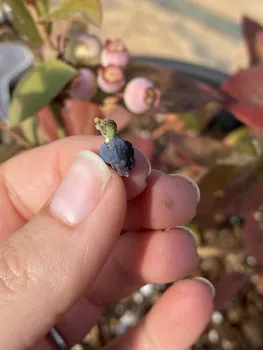
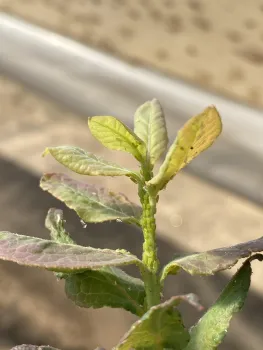
We will also be testing scale-appropriate pest and disease management techniques. Many pest management techniques are tested and developed for large-scale commercial growing operations and are difficult or unreasonable to use on a small scale, so we'll be developing methods that can easily be implemented in small-scale urban settings.
